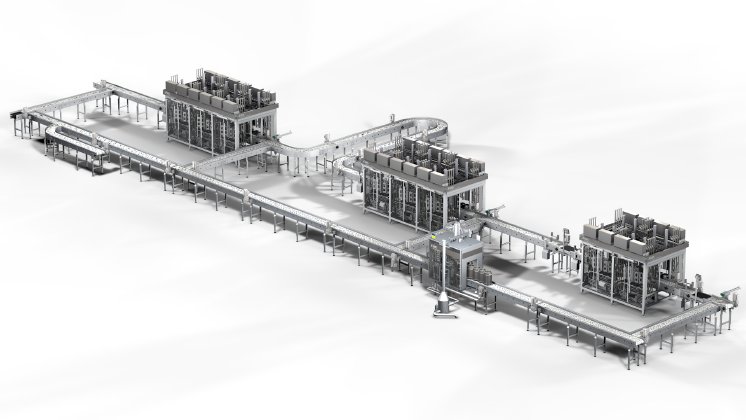Conventional transversal keg systems are characterized by a module ratio of one processing station to two conveying stations. The processing stations of these systems are located between the infeed and discharge conveyors. The discharge conveyor of KHS' Innokeg AF-C in contrast is positioned between the processing stations. The kegs are pushed sideways from this conveyor to these stations and back. Breweries benefit from this innovative concept. In addition to optimizing space utilization, this design also considerably improves the accessibility to the racking and washing stations.
Innovative design to meet increasing requirements
A new feature of the modular and material-saving design is that it reduces acquisition costs on the one hand and allows the KHS Innokeg AF-C to grow correspondingly with increasing production volumes on the other. "We group up to four processing stations together in one module frame. Thanks to the compact design, this group to fits into one shipping container," says Roger Daum, Keg Product Manager, explaining the design of the new system. All conceivable cycles are possible within these frames. "Up to four module groups can be combined to create a processing machine that operates as a pre-washer, main or combined washer, or as a racker," Daum adds.
In addition to a high level of flexibility, this special design also ensures increased efficiency during on-going operation. Processing modules can be easily added and removed from the group. This makes it easy to expand the system with additional modules. This is made possible by the centrally located conveying segment that also improves machine accessibility. The ergonomic design provides operators direct access to the processing modules without the access-blocking external conveyors of the common transversal systems to date.
Intelligent control system for high machine availability
Intelligent keg conveying logistics is of particular importance in view of the compact design and high capacity. The processing sequences are simulated and optimized in advance according to the desired cycles and the size of the system. "For this, the various keg processing times have to be taken precisely into account in each of the processing steps," Daum explains. Keg stoppers ahead of the processing machine space the containers required distance apart before they enter the machine.¬ The conveyors also play an important role in this fine-tuning: the length of the conveying segment is adapted according to the exposure time specified by the customer for the kegs filled with caustic solution between pre-washing and main washing steps.
The KHS Innokeg AF-C is suitable not only for returnable kegs: one-way kegs can optionally be racked without changing over the line. The user does this by switching off the keg washers so that the kegs pass through the machine to the racker. "This is ingeniously simple," remarks Daum while emphasizing that this kind of flexibility has not been offered on the market to date. The system has been designed for medium-sized companies and larger bottling plants. In addition to beer, it is also possible to rack wine and carbonated beverages.
The IO-link technology used in the Innokeg AF-C reduces the cost of installing the wiring by up to 50%. This also shortens the time required for installation noticeably. The AF-C can be operated by a tablet or smartphone using the latest in control technology. Changes to the production process, such as changeover to a different keg type or product are thus easily completed. It is also possible to shut down the line at the end of production and to start CIP cleaning.



